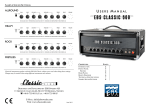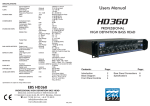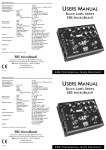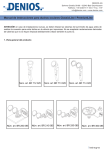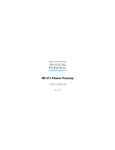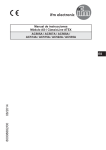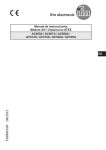Download U SERS M ANUAL
Transcript
USERS MANUAL CONTENTS: INTRODUCTION FRONT AND REAR PANEL FILTERS MAINTENANCE BLOCK DIAGRAM TECHNICAL SPECIFICATIONS DESIGNED AND DEVELOPED BY EBS SWEDEN AB GRINDSTUVÄGEN 44-46, SE-167 33 BROMMA, SWEDEN +46-8-735 00 10, FAX : +46-8-735 00 05 E-MAIL: [email protected] WEB: www.ebssweden.com June 2009 PAGE: 2 3 4 5 6 7 INTRODUCTION • GETTING STARTED TECHNICAL SPECIFICATIONS The EBS ClassicT90 is an all tube amplifier head, extremely easy to dial-in. It is designed to match the EBS ClassicLine cabinets in all styles and situations. The sound of the ClassicT90amp is pure vintage, yet with a recognizable transparent ’EBS’ sound that let your playing style and the character of your instrument speak. Versatility is provided by a carefully designed EQ section. These brief tutorials will help you to become acquainted with some of the features of the EBS ClassicT90. BUILDING THE SOUND... GETTING STARTED... 10. Proceed to the prescence knob. This control adjusts the high frequency response of the power amp and lets you define the "crunch" when distorting the amp. INPUT: Your EBS ClassicT90 features a tone shaping circuit that will enable you to create a variety of vintage bass sounds. 9. 1. Carefully unpack the bass head. 2. Connect a speaker to the head. Make sure that the impedance of the cabinet match exactly with the output of the T90. 3. Turn down the Volume and set all other controls to mid position. The bass and treble filters are basically of the boost/cut design. This means that the controls practically boost or cut the selected frequency band. Gradually increase or decrease the level and tone controls. Notice how the sound is affected. This was a brief tutorial of EBS ClassicT90. As you go on further in this manual, you will learn how to use and utilize all of the useful features that the EBS ClassicT90 offers you. 4. Power up the head and wait five(5) minutes for the head to warm up. The tubes should now glow. 5. Connect your instrument to one of the inputs. If your bass is active or has high output it is recommended to use the active input, otherwise use the passive one. 1 Mohms (passive) 100 kohms (active) -20dBv (passive) -8dBv (active) Nominal Input Level TONE CONTROLS: 8. Input Impedance Bass Filter: Type Treble Filter: Type 0 - +12 dB @ 5 kHz (Pwr amp feedback) PRESCENCE: BALANCED OUTPUT: Output Level XLR Connections Options nominal - 10 dBv 1-GND, 2-Hot, 3-Cold GND Lift POWER AMP: Continuous Output Power Load Impedance 90 W RMS 4 or 8 ohms TUBE SELECTION: Input / Filter Balanced Output / Buffer Power Amp Driver Power Amp 1x 7025 low noise 2x 12AU7 1x 12AT7 2x 6550 AUXILIARY INFO: Power Requirements Mains Protection: max Fuse Dimensions (WxHxD): Weight: Specifications are subject to change without notice! GOOD LUCK! 6. Toggle the standby switch so that the associated lamp light up. 7. Move over to the VOLUME knob and adjust for the desired output volume. 2 Shelving +/- 12 dB @ 80 Hz Shelving +/- 12 dB @ 8 kHz 7 200 W T1.5A (230/240V) T3.15A (100/120V) 537 x 267 x 243 mm 21.1 x 10.5 x 9.57” 17.1 kg ( 38 lbs.) BLOCK DIAGRAM FRONT AND REAR PANEL INPUTS - Connect your instrument to one of these inputs, active or passive. Use the active input for instruments with high output and the passive one for instruments with low output. If both inputs are connected only the passive input will work. ___________________________________ BALANCED OUTPUT - Is a high quality balanced output that functions as a line box for connecting to PA mixing consoles or to studio or broadcast recording units. Lifting ground is a great aid in many occasions. When required, set the GND switch to OFF position to disconnect the ground from the output. This balanced output is a direct driven tube output for best possible performance. __________________________________ VOLUME - This knob controls the volume of unit, for the exception of the balanced output (XLR) which is not effected by the this setting. ___________________________________ AC INLET - Connects the amp to the mains. This inlet also houses the mains fuse. __________________________________ BASS and TREBLE - These two controls the tone stack of the ClassicT90. The design is purely passive, yet it is designed as a boost/cut filter for best performance. No feedback is present here, and this filter is driven by a class A driving stage. See next page for filter characteristics graph. ___________________________________ SPEAKER OUTPUTS – The two Speakon® connectors allow you to connect the amp to your favorite cabinets. IMPORTANT: Use only ONE speaker output and the one that is matching the TOTAL speaker impedance. PRESENCE - Controls the high frequency response over the poweramp feedback circuitry. Very useful for defining the "edge" or "attack" of a sound. Note that this control does not effect the balanced output.. ___________________________________ , STANDBY – This switch mutes the amp by disconnecting the high voltage from the tubes. The associated lamp indicated when the amp is operable. When powering up, allow the to amp warm up for a period of 5 minutes prior of activating with standby. ___________________________________ EBS will not take responsibility for eventual hearing damages caused by the powerful ClassicT90. __________________________________ POWER – Powers the amp on or off. ___________________________________ 6 3 FILTERS MAINTENANCE Typical filter characteristics for Bass and Treble filters: CHANGING THE TUBES - Although it may not be necessary due to tube malfunction, changing the tubes once in a while will regain the tone and bring back high performance. There are however some points that are important: SETTING THE BIAS - Whenever the power tubes have been changed it is necessary to set the correct bias to ensure long life operation. This is the procedure: 1. 2. 2. 3. 4. 1. When changing the power amp tubes, both tubes must be changed, and the tubes need to be a matched pair. Recalibration of the bias is always necessary after installing new power tubes. 3. 4. The power tube driver, 12AT7 should be changed every second time the power tubes are changed. 5. 6. The input tube, 7025, must be selected for low microphony, low noise and high gain. Alternately, you may use an 12AX7 or ECC83 here. IMPORTANT: Incorrectly set bias may cause permanent damage to the amplifier. If you are not 100% sure on how to do this, please get in touch with a service center. The buffer and balanced out tube must be same type as original, 12AU7. TUBES PLACEMENT: 4 Power the amp at let it warm up for 5 minutes. Connect a voltmeter to the bias measurement point VA at the rear panel. Switch on the amp by toggling the standby switch. Adjust with the associated bias trimmer so that the readout on the meter is 35mV +/-2mV. Repeat for other tube using point VB. After first calibration repeat once for verification of bias setting. 5




